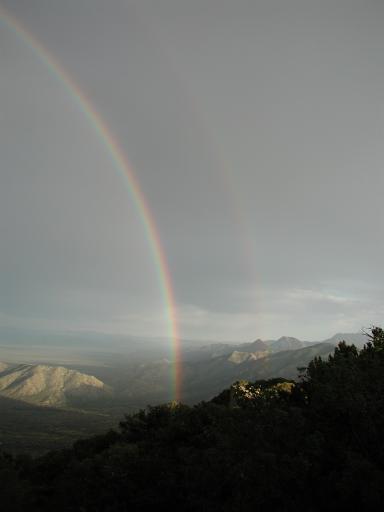An Introduction to Solar System Astronomy
Prof. Richard Pogge, MTWThF 9:30
|
|
Astronomy 161: An Introduction to Solar System Astronomy Prof. Richard Pogge, MTWThF 9:30 |

Rainbow over Kitt Peak, Arizona, July 2001 [R. Pogge]
Gravitation binds together all masses in the Universe, governing the fall of an apple and the orbit of the Moon about the Earth. The dance of the planets around the Sun is choreographed by the interplay of gravitational forces. Newton's laws are not mere empirical descriptions, but powerful physical tools we can use to explore the Universe, both figuratively and literally!
Nearly everything we know about the Universe beyond the Earth has been learned from a distance. We cannot directly measure a star, or scoop up a bit of its material to study in a laboratory. We only have to us the light that comes to use from across effectively unbridgable distances. Because light, or more precisely, Electromagnetic Radiation, is produced by and interacts with ordinary matter, what seems at first an insuperable handicap becomes a source of great strength. It is when we began to understand the nature of light, how it is produced and how it interacts with matter, that marked the end of "Astronomy" as a simple cataloging of the heavens as it had been primarily from its very beginnings, and the beginnings of the modern study of "Astrophysics" at the end of the 19th Century.
In this unit, we will explore the four Force of nature, as manifested in Gravitation, Electromagnetic Radiation, and the structure of the Atom. This leads us into a discussion of spectroscopy, the study of how we can "decode" the message of light from space, the basic principles of optics, and how we build telescopes to gather light from space and analyze it.

|
Lecture Audio Podcasts |
The links above reproduce the electronic overheads shown in class for each of the lectures. In some cases they have additional text and links covering supplemental material or graphics. Online lecture notes are made available starting the week in which the lectures occur, but some notes may not be accessible until later in the week if I am having problems translating them into a web-accessible form.
Please feel free to print out copies of these lecture outlines in advance of class, so you can follow along with the lecture. Many students find this helps them listen without the pressure of taking down detailed notes of their own, but while still making additional notes in the margins to highlight particularly emphasized points.
Also, see A Note about Graphics if you are curious as to why some of the pictures shown in the lectures are not reproduced with these notes.
Students wishing to explore some of these topics beyond the lecture and textbook using the Internet might want to look at the relevant Selected Astronomical Internet Links for this unit.